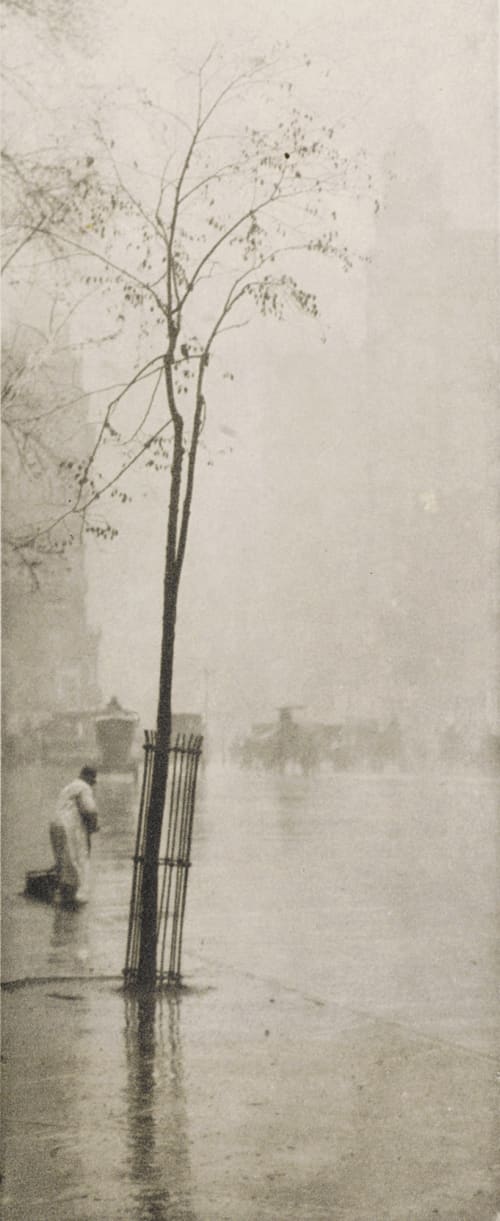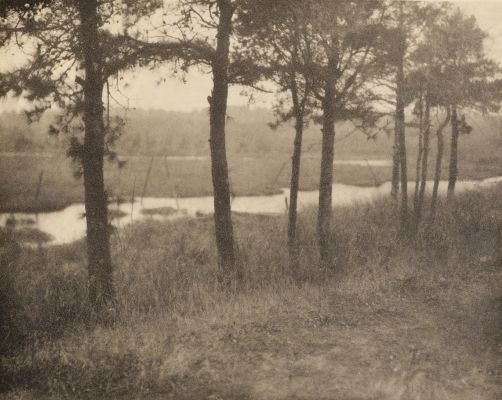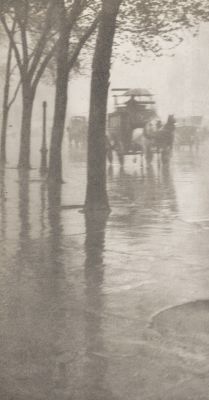
Title
Spring Showers, The SweeperArtist
Stieglitz, Alfred (American, 1864-1946)Key FigurePublication
Camera Notes Vol. 5 No. 3Date
1902 plate (1900 negative)Process
PhotogravureAtelier
Photochrome Engraving Company, New YorkImage Size
15.5 x 6.2 cm
By the late 1800s trees along the streets of New York (as distinct from those in parks) were a dwindling urban resource, their shrinking numbers were a vivid mark of irrevocable alteration of Manhattan’s topography caused by commercial development. In this atmospheric image imbued with mood, a young tree is surrounded by an iron fence while a street sweeper works to safeguard it. The Street Cleaner is a sign not only of nature and the seasons but also of human intervention to reestablish this natural cycle in the city by planting new trees. Although Stieglitz refers to the street cleaner in his title, he took the photograph from a vantage point that made the slender young tree and its delicate branches more central to the elongated composition and more distinct than the human figure. [1]
Reproduced / Exhibited
Crawford, William. The Keepers of Light. Dobbs Ferry: Morgan and Morgan, 1979. fig. 99
Davis, Keith F. An American Century of Photography: From Dry Plate to Digital. Kansas City, Mo: Hallmark Cards, 1999. Print. P. 63
Doty, Robert M. Photo-secession: Photography As a Fine Art. N.Y: Eastman, 1960. plate IV.
Frizot, Michael. New History of Photography. Place of publication not identified: Pajerski, 1999. Print p. 320
Greenough, Sarah, and Alfred Stieglitz. Alfred Stieglitz: The Key Set : the Alfred Stieglitz Collection of Photographs. Washington, D.C: National Gallery of Art, 2002. Pl 270
Heilbrun, Françoise, and Quentin Bajac. Orsay: Photography. , 2000. pl. 131
Hoffman, Katherine. Stieglitz: A Beginning Light. New Haven: Yale University Press, 2004. no. 184.
Homer, William I, Catherine Johnson, and Alfred Stieglitz. Stieglitz and the Photo-Secession, 1902. London: Penguin Putnam, 2002. Cover
Johnston, Patricia A. Seeing High & Low: Representing Social Conflict in American Visual Culture. Berkeley: University of California Press, 2006. fig 11.7
Kruse, Margret. Kunstphotographie Um 1900: D. Sammlung Ernst Juhl; Hamburg: Museum für Kunst u. Gewerbe, 1989 pl. 864
Langer, Freddy, Timm Starl, and Wilfried Wiegand. Icons of Photography: The 19th Century. Munich: Prestel, 2002. p. 124
Madigan, Mary J. S, and Susan Colgan. Prints & Photographs: Understanding, Appreciating, Collecting. , 1983 p. 131
Nordström, Alison D, Thomas Padon, and J L. Ackerman. Truthbeauty: Pictorialism and the Photograph As Art, 1845-1945. Vancouver, B.C: Douglas & McIntyre, 2008. Print. p 51
Peterson, Christian A. Camera Work: Process & Image : [exhibition, Minneapolis, Minneapolis Institute of Arts, August 31-November 3, 1985, Seattle, Seattle Art Museum, November 22, 1985-February 2, 1986]. Minneapolis: Minneapolis Institute of arts, 1985. p. 71.
Pollack, P. The Picture History of Photography: From the Earliest Beginnings to the Present Day. New York: Harry N. Abrams, Inc, 1998. p. 268
Stieglitz, Alfred, Richard Whelan, and Sarah Greenough. Stieglitz on Photography: His Selected Essays and Notes. New York, NY: Aperture Foundation, 2000. p. 115
Stieglitz, Alfred, and Dorothy Norman. Alfred Stieglitz. New York: Aperture, 1976. p. 33.
Trachtenberg, Alan. Reading American Photographs: Images As History : Mathew Brady to Walker Evans. New York: Hill and Wang, 2008. pl. 66
Whelan, Richard. Alfred Stieglitz: A Biography, 1997. pp. 310-311
References
[1] Lukitsh, Joanne. "Alone on the Sidewalks of New York: Alfred Stieglitz’s Photography, 1892 – 1913." Seeing High Et Low / Ed. by Patricia Johnston. (2006): 210-227.


